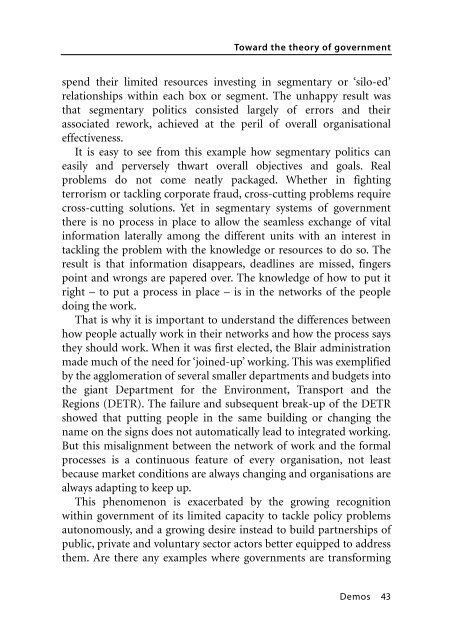Network Logic - Index of
Network Logic - Index of
Network Logic - Index of
Create successful ePaper yourself
Turn your PDF publications into a flip-book with our unique Google optimized e-Paper software.
Toward the theory <strong>of</strong> government<br />
spend their limited resources investing in segmentary or ‘silo-ed’<br />
relationships within each box or segment. The unhappy result was<br />
that segmentary politics consisted largely <strong>of</strong> errors and their<br />
associated rework, achieved at the peril <strong>of</strong> overall organisational<br />
effectiveness.<br />
It is easy to see from this example how segmentary politics can<br />
easily and perversely thwart overall objectives and goals. Real<br />
problems do not come neatly packaged. Whether in fighting<br />
terrorism or tackling corporate fraud, cross-cutting problems require<br />
cross-cutting solutions. Yet in segmentary systems <strong>of</strong> government<br />
there is no process in place to allow the seamless exchange <strong>of</strong> vital<br />
information laterally among the different units with an interest in<br />
tackling the problem with the knowledge or resources to do so. The<br />
result is that information disappears, deadlines are missed, fingers<br />
point and wrongs are papered over. The knowledge <strong>of</strong> how to put it<br />
right – to put a process in place – is in the networks <strong>of</strong> the people<br />
doing the work.<br />
That is why it is important to understand the differences between<br />
how people actually work in their networks and how the process says<br />
they should work. When it was first elected, the Blair administration<br />
made much <strong>of</strong> the need for ‘joined-up’ working. This was exemplified<br />
by the agglomeration <strong>of</strong> several smaller departments and budgets into<br />
the giant Department for the Environment, Transport and the<br />
Regions (DETR). The failure and subsequent break-up <strong>of</strong> the DETR<br />
showed that putting people in the same building or changing the<br />
name on the signs does not automatically lead to integrated working.<br />
But this misalignment between the network <strong>of</strong> work and the formal<br />
processes is a continuous feature <strong>of</strong> every organisation, not least<br />
because market conditions are always changing and organisations are<br />
always adapting to keep up.<br />
This phenomenon is exacerbated by the growing recognition<br />
within government <strong>of</strong> its limited capacity to tackle policy problems<br />
autonomously, and a growing desire instead to build partnerships <strong>of</strong><br />
public, private and voluntary sector actors better equipped to address<br />
them. Are there any examples where governments are transforming<br />
Demos 43
















